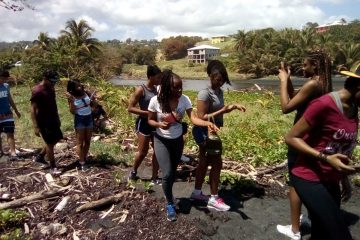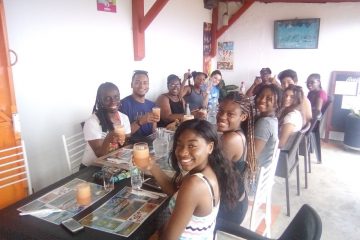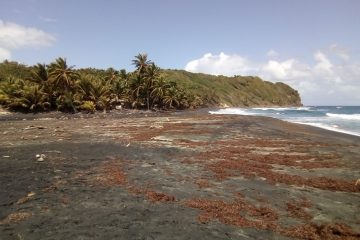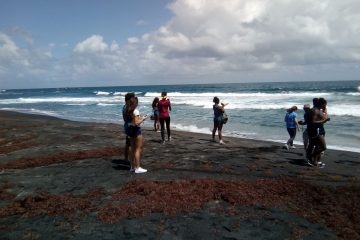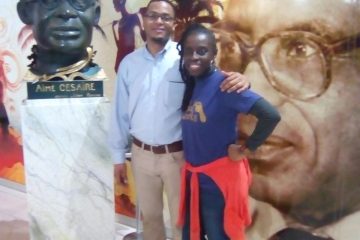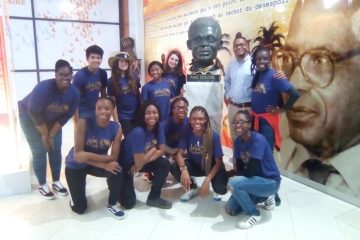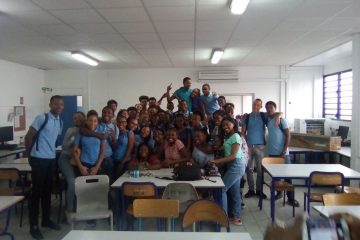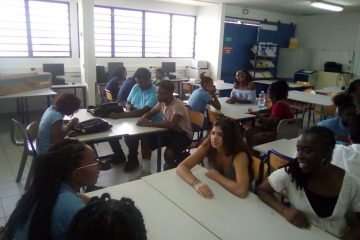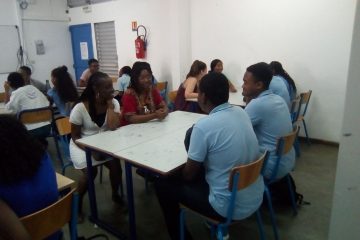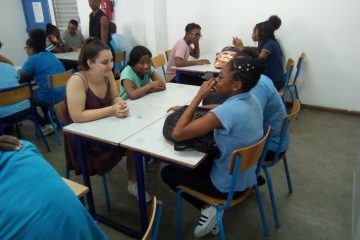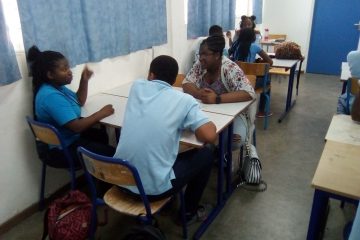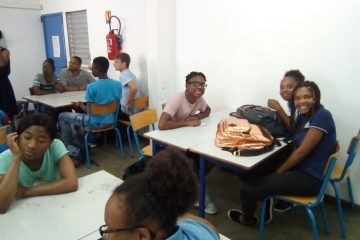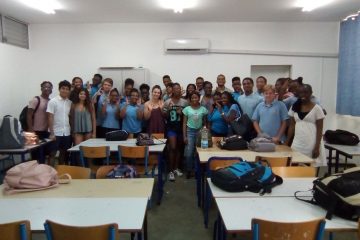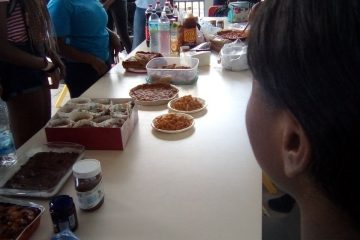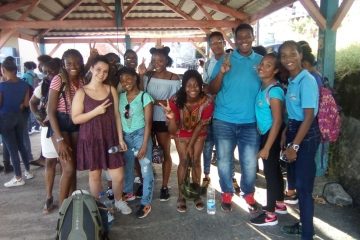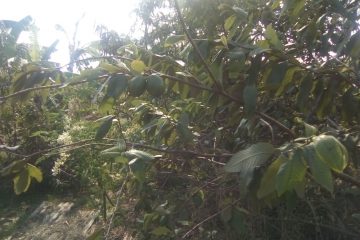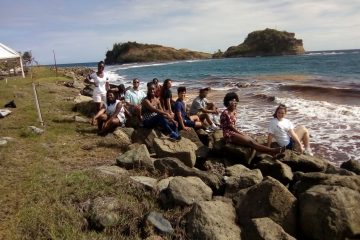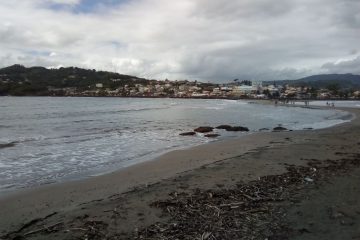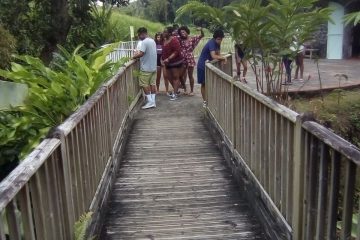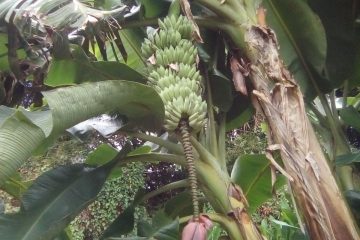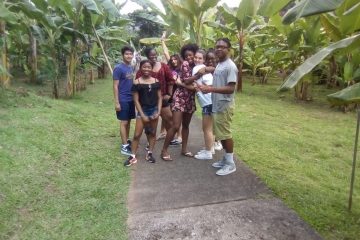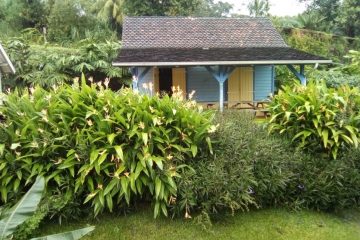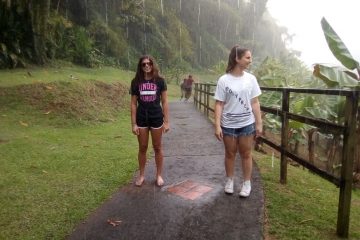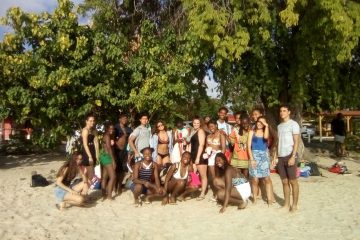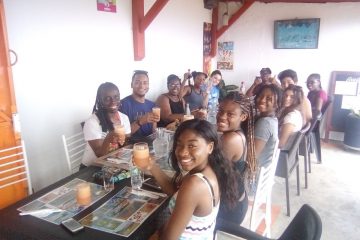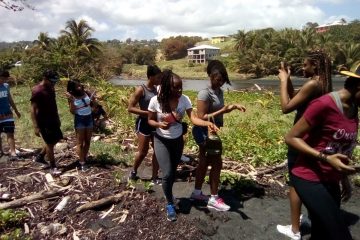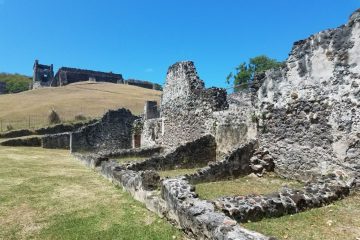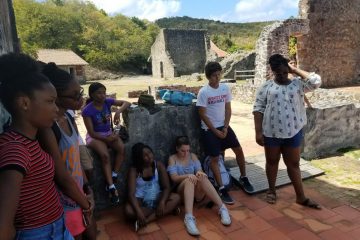March 17, 2018
This morning we woke up at 8:30 and had a great breakfast of croissants, bread, cereals, fruits in the sunny weather of Martinique. We took a bus ride across the island from the Atlantic side to the Caribbean, stopping at a black sand beach. There we took pictures of the breezy shore. We then went to one of the highest point in Martinique and learnt about the volcano Mount Pelée as well as the disappointingly recent struggle for abolition. We went to a restaurant and practiced ordering foods and drinks in French, getting to dine with natives at the altitude of the clouds. After lunch the bus took us to a mesmerizing valley with a clear stream racing through. We trekked through a gorge to the base of a waterfall, getting soaked, overcoming fear and growing closer as friends. After a swim back at the hotel, we went to a fun dinner. A beautiful walk under the stars led us back to the hotel were we played uno and headed to sleep.
– Nick and Julia signing off
March 18, 2018
We got up around 7:30 and decided to go in the pool. Although it was really early, when we got there, Julia was already sunbathing ! We just stayed there til 11 o’clock. Gradually more people came and we played cards, swam and just talked. We also ate breakfast at around 8:30. I ate a lot of croissants. Some of the group decided to go to church. After taking in all that sun at the pool while waiting for them, it was time to pack and leave. We went on a picnic by a castle by the guy I called the ‘dishonorable musketeer’. After lunch we headed towards the south to meet the homestay families. I was a bit nervous but after meeting my family, the nervousness was gone. I was paired up with a boy named Noa and we have a little sister, 2 cats and a dog. When we got there, Noa, Nick and I decided to play a couple games of pool. Compared to Noa, Nick and I were very bad, but we got better. After our games we had dinner which was SUPERB ! Finally I took a shower and headed to bed. I was really tired and even though it was around 9, I fell asleep really quickly.
– Akil F.
March 19, 2018
When we visited the local high school, participating in an exchange with the students was very enjoyable because we were able to practice speaking French, while also helping them practice their English. At the end of the day, we ate pastries and other foods with the students, and this gave us some time to become more familiar with them and talk with them about some of the things they like to do for fun, and we even had the chance to dance with them and share music we like. After this cultural exchange with the students, at the Jardin de Sante, we got to see how locally grown fruits and plants can be used to make juices and medicines that have a multitude of health benefits. Even though we have many of the same fruits in America, it was so interesting to see the various methods used for growing crops such as how a more efficient system of irrigation is used here and how the pile for compost doesn’t need to be turned over every so often because tree branches have been placed in them to provide natural airflow. These are only some of the things that we learned, and overall it was fascinating to see that so many different things go into growing food and that there are different ways to accomplish them.
-Nyla Welsh
March 20, 2018
Today, we parted the Red Sea (Blue Sea) and Julie led the Poly Prep students through the rare sight. The Tombolo is a portion of the sea that separates once a year and reveals a sandy walkway that people cross over. We took photos and Akil taught us how to skip rocks. In between the rocks, black crabs scattered into the water. The Tombolo was geographically phenomenal and everyone enjoyed some portion of the aquatic attraction.
-Lotoya and Sade T.
Today, after our visit to the Tombolo, we had the opportunity to dance and learn about the history of Bele, the dance of Martinique.
I was especially excited for this dance lesson. after our visit to the school yesterday when members of the English Club performed it for us. The dance consisted of some simple footwork to be performed by a male and female couple. The instructor compared the hip movement to stirring a cup of tea. He was an interesting man with a multicolored scarf tied to his head. He was very talented and very light on his feet, which was evident during our lesson but even more so when he danced for us with a large wooden table on his head.
The instructor also taught us about the story behind Bele. Female dancers usually wear long flowery skirts which they hold with the tips of their fingers while the men wear hats that they use to gesture to their partners while dancing. He also explained the drummer’s intimacy with their drum which they regard as sacred and the 5 beat rhythm. Bele is taught to people of all ages and us often used as an early detector of childhood development because dancers need to be able to move freely, walk, hear and count the rhythm of the drum. The rhythm, dance and song reminded me of African dance and drum at Poly. All the elements of the dance had meaning. The song was about the importance of protecting the environment. One thing I find most interesting was something I read on one of the displays at the museum which explained that both Bele and Creole were closely affiliated with blackness, slavery and poor behaviour so many avoided them. Later, both were revived as people of Martinique tried to reclaim their culture with pride.
-Lotoya
The banana museum took and interesting curve (no pun intended). The first part of the museum was a small, dimlit room. Along the walls of the room were interactive fun facts about bananas. For all banana lovers, there were some samples # I hate bananas, but I enjoyed learning about something that’s so common in our everyday life. The banana museum taught me that there are 300 different bananas and that 75% of a banana’s genetics is water. The way that bananas grow was also visually striking. The rest of the museum took place outside. It started pouring so we briskly walked to the gift shop. The banana leaves dripped and my afro shrunk. We additionally got the chance to taste some banana ketchup. Conclusively, we were educated on the deep history of a fruit that most people just regard as a simple breakfast staple.
-Sade T.
March 21, 2018
I think I can safely say for the rest of us that we’ve gotten used to waking up at 6. We don’t like it, but the days are fun! We just got back our phones and we are so happy. It’s been 3 days but it felt like a month. We drove down a long road each side filled with trees and bushes and vast blue open space. After the cane museum, were we learned a lot about sugar cane and it’s history, we visited La Savane des Esclaves. An exhibit about Martinique’s history during and after slavery. We saw slave quarters, gardens and statues representative of the history.
Then we spent the afternoon at a beautiful beach and there we met up with some of the students we met on Monday.
We played games in the water and had an ice cream just before we had to head back to the school where our families were waiting for us.
-Jeanine

